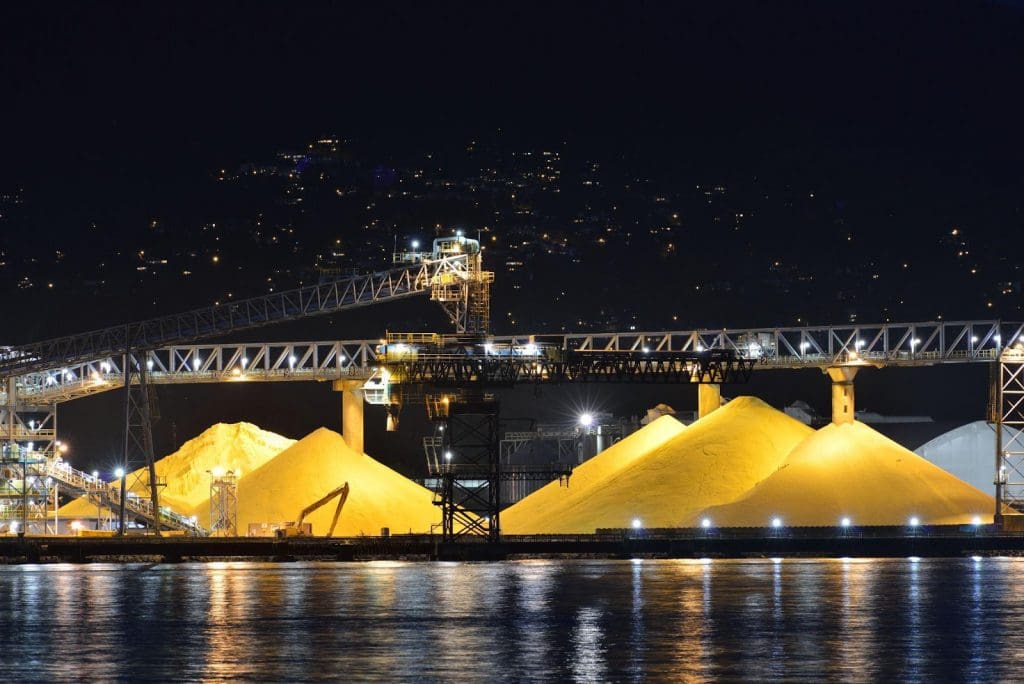
Sulfuric acid is a key component in many industrial chemical processes, from fertilizer manufacturing to wastewater processing to chemical synthesis.
Most of the world’s sulfur is found in the ground, from minerals such as pyrite (iron sulfide) and other sulfide or disulfide compounds. However, rather than direct extraction from the earth, more than 80% of the sulfur used industrially is a waste product, removed during the refinement of fossil fuels to prevent sulfur dioxide emissions.

With the trend toward clean and renewable energy sources looming over the fossil fuel industry, is there a future for sulfuric acid as we know it?
Over 85% of the sulfur we use is converted into sulfuric acid, an acid widely-used across the chemicals industry in the processing and production of hundreds of different compounds. It’s a highly corrosive mineral acid with the molecular formula H2SO4, also known as ‘oil of vitriol’.
It is a colourless to slightly yellow viscous liquid, soluble in water at all concentrations. At times, you might find it to be dark brown, as it’s often been dyed during industrial production processes to alert people to its hazardous nature. Sulfuric acid is a diprotic acid and may show different properties depending upon its concentration. Being a strong acid, sulfuric acid is corrosive to metals, stones, skin, eyes, flesh and other materials. It can also char wood (but won’t cause a fire). These effects can mainly be put down to its strong acidic nature, and, if concentrated, its strong dehydrating and oxidising properties.
Sulfuric acid can be found in a number of situations—it’s a component of acid rain and battery acid, and can even form when some toilet cleaners mix with water. Sulfuric acid is most often used in the production of phosphate fertilisers. It also finds uses in manufacturing explosives, other acids, dyes, glue, wood preservatives, and car batteries. It’s also used in the purification of petroleum, the pickling of metal, copper smelting, electroplating, metal work, and the production of rayon and film.
With the growing climate change crisis and the drive to replace fossil fuels with renewable energy sources, industry as we know it will need to change. Industry has adapted to the demands of oil and gas by trying to reduce waste and maximise efficiency, including repurposing byproducts and impurities, such as sulfur, which would otherwise cause environmental damage.

Sulfur is usually present in fossil fuels at about 1-3% by weight, which accounts for 80% of the more than 80 million tonnes of annual global sulfur supply. The switch toward renewable energy is imminent, however, and with it an overhaul of crucial chemical processes and a loss of key reagents such as sulfuric acid in the scales we have currently. It’s predicted that demand will outstrip sulfur supply by anywhere from 40 to 130% by 2040, depending on the extent of renewable energy infrastructure.
One of the most obvious solutions is to mine sulfur from the ample sulfide and sulfate mineral deposits within the Earth’s surface, as was the primary source of sulfur in the mid-twentieth century. However, mining in its current state also holds large costs to the environment and to people, due to particulate matter and heavy metals exposure which should ideally be avoided.
Reducing the total amount of sulfur needed industry-wide could be achieved through more careful recycling practices and is a potential option to curb demand. Recycling fertiliser waste would go a long way in reducing the amount of raw phosphate rock that needs to be acid-treated to create new fertiliser. Additionally, the recycling of sulfate salt by-products brought about by sulfuric acid chemical processes could help recover significant portions of sulfur. However, the most viable product from this recycling process is toxic hydrogen sulfide gas, so more research is needed to flesh out this idea.
Replacing sulfuric acid with alternatives could be possible in some respects. Nitric acid has been suggested as an acid capable of processing rocks at a similar level to sulfuric acid, however the wastewater produced specifically in phosphate extraction for fertiliser is radioactive. Sulfuric acid is also used in lithium-ion batteries, so better battery recycling infrastructure or finding alternative forms of energy storage could go a long way.
If you want to know more about the health and safety of chemicals, or how to minimise risk while working with chemicals, we’re here to help. We have tools to help you with mandatory reporting, as well as generating SDS and Risk Assessments. We also have a library of webinars covering global safety regulations, software training, accredited courses, and labelling requirements. For more information, contact us today at sa***@*******ch.net.
Sources: